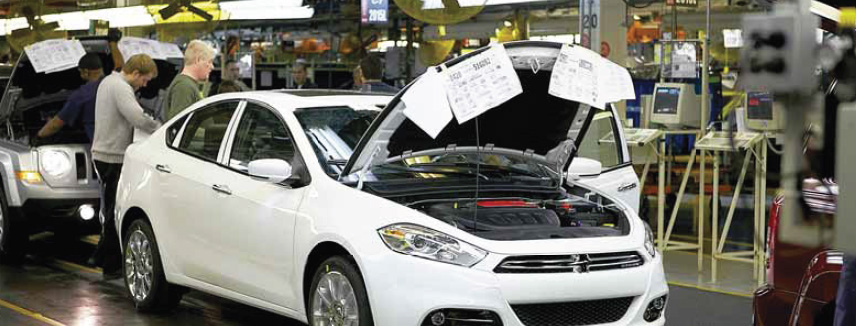 Facing a bleak future just a few short years ago, Chrysler has rebounded with a strong line of products and a manufacturing philosophy that highlights its focus on globally competitive production. When restructuring with Fiat began in 2009, Chrysler dedicated itself to World Class Manufacturing (WCM). Scott Garberding, senior vice-president, manufacturing/worldclass manufacturing at the Chrysler Group, talks about the company’s manufacturing philosophy.
Facing a bleak future just a few short years ago, Chrysler has rebounded with a strong line of products and a manufacturing philosophy that highlights its focus on globally competitive production. When restructuring with Fiat began in 2009, Chrysler dedicated itself to World Class Manufacturing (WCM). Scott Garberding, senior vice-president, manufacturing/worldclass manufacturing at the Chrysler Group, talks about the company’s manufacturing philosophy.
 AMS: How does Chrysler’s WCM philosophy coincide with your alliance partner Fiat’s philosophy?
AMS: How does Chrysler’s WCM philosophy coincide with your alliance partner Fiat’s philosophy?
Scott Garberding: In 2006, Fiat introduced a holistic operating system for its plants based on Toyota’s LEAN manufacturing system, adding some methodologies that moved plants from a traditional operating system to WCM. Chrysler adopted this same operating system when it formed an alliance with Fiat in June 2009.
AMS: As a part of WCM, how did Chrysler and Fiat synergise some of their labour practices?
SG: Sergio Marchionne [chairman and CEO of the Chrysler Group and CEO of Fiat] wanted a more meaningful team structure in which the hourly employee plays a leading role. We worked with our workforce to teach them the WCM methodology, develop workplace organisation skills, and made them responsible for developing detailed workplace instructions for each of the work stations. In fact, the team leader takes a huge amount of ownership the assembly process.
AMS: How has WCM improved Chrysler’s production processes?
SG: WCM has changed all of the fundamental pieces of our business. We’ve made significant progress in many areas, but most importantly in safety. Chrysler has been able to reduce its injury rates by more than 15% annually since 2009.
AMS: How has Chrysler improved the quality of its workplace environment?
SG: Through WCM, Chrysler has focused on workplace organization, which is about how we organize the work within the work station to improve the safety and logistics flow while removing waste. We also analyse ergonomic risk as a means of reducing waste and make changes so that our employees are working more safely. This has been the underlying driver of our productivity improvements over the last couple of years.
AMS: What other best practices has Chrysler gained from Fiat?
SG: All of the methodologies we’re implementing to improve safety, quality and productivity have been learned from Fiat. The fact is that having a common operating system is better for the exchange of best practices. This includes using a common set of metrics.
We also exchange people for workshops and focused activities. This makes it easier for us to work together, which has enabled us to adopt WCM and achieve improvements more quickly.
AMS: What are the main synergies with Fiat that Chrysler has achieved thus far?
SG: The bulk of our vehicles are now being developed on a common architecture. The Fiat design has been modified to better fit in the North American market. This has allowed Chrysler and Fiat to develop a common processing scheme. Meaning, we’re not starting with a clean sheet of paper, but rather with a standard design that benefits from continuous improvement. A common processing scheme enables us to improve the product launch quality and enhances production flexibility in the NAFTA region and in Europe. We deploy a standard processing package worldwide, which in itself is a significant driver of efficiency and quality.
AMS: What issues have you faced in transitioning your heavier vehicles, such as Jeeps and SUVs, away from bodyon- frame construction to unibody construction?
SG: The Dodge Durango is our only vehicle that had previously used body on frame construction and last year, we began building it with unibody construction. We have built the Grand Cherokee as a unibody design since its inception. When we created the current Dodge Durango, we started with a Grand Cherokee platform, modified to satisfy a three row vehicle. This results in a much stiffer body structure, better handling, improved noise vibration performance, and less weight.
AMS: What challenges have you experienced with accommodating two body architectures on the same line as you’re doing in Belvidere?
Scott R Garberding’s path to becoming senior vice-president of manufacturing/ world-class manufacturing at Chrysler
• December 2009 – senior vice-president of manufacturing/world-class manufacturing, Chrysler Group LLC
• September 2009 – head of manufacturing/ world-class manufacturing ad interim
• 2009 – senior vice-president, purchasing
• 2008 – senior vice-president and chief procurement offi cer, Chrysler LLC
• 2008 – vice-president, global alliance operations
• 2007 – vice-president, supply and supplier quality, Chrysler Group, DaimlerChrysler
• 2003 – vice-president, supplier quality and product team program management
• 2001 – enterprise manager / plant manager, Detroit Axle plant
• 2000 – plant manager, Jefferson North Assembly plant
• 1999 – plant manager, Dayton Thermal Product plant
• 1998 – manufacturing manager, Trenton Engine plant
• 1997 – manufacturing engineering manager, Trenton Engine plant, Chrysler Corporation
• 1996 – manager, Chrysler Operating System Group
SG: In Belvidere, we’re producing three vehicles on two very distinct architectures. To try to create one body-in-white process while continuing to run two shifts of production of the Jeep Compass and Jeep Patriot would have been difficult, inefficient and would have led to a very complex body-in-white process. Therefore, we decided to build an all new body shop that is standard with Fiat. The Compass and Patriot are still built in the existing body shop. Both body shops feed into the same assembly process. We elected to build a new body shop for a number of reasons including the amount of welding and subassembly work we are doing in house, the number of welds, and the shingling process involved is quite different car to car.
AMS: How has Chrysler’s move from compressed air to servo operation of many tools progressed?
SG: The reason that we use servo operation tools is to achieve more precision and more control. Servo operation tools require a greater amount of investment. We use them either for quality purposes or to obtain more feedback from the process than we do with compressed air. However, compressed air is still widely used. We still use it and we receive data feedback.
AMS: In what ways has Chrysler been modernising its older plants and what are your plans to continue modernisation?
SG: Most of our plants have changed drastically within the past two and a half years. They are more attractive, more functional, better lighted, cleaner, and better organised. Our first efforts to improve our facilities started with returning key pieces of equipment back to the same condition as when they were purchased. One of the lessons we learned was that not keeping the equipment in that condition was creating more problems resulting in more expense. The investment for restoring basic conditions is self-funded by the plants. As they make improvements, they divert the money from those improvements into more improvements. We have also created more detailed facility standards that focus on safety with improved aisle designs and pedestrian walkways.
AMS: What types of plant improvements are you making that involve more efficient energy utilisation?
SG: We are working on some interesting energy projects, which include such things as changing to more efficient lighting to working on air supply houses and HVAC systems. We are working on reducing sources of heat loss. This involves changing from steam heat to direct fired gas, which consumes less energy and is a more economical approach. In making these changes, we have achieved a significant improvement in energy use per vehicle.
AMS: How does Chrysler balance the cost of modernising an older plant with the possible cost savings of starting a Greenfield plant?
SG: We are always looking at both options. In some cases, it may not make sense to invest in an older facility. Our current facility footprint is an advantage from a logistics standpoint as 50% to 60% of our suppliers are located within 150 miles of our plants. As fuel becomes more expensive and the regulatory environment changes, and the complete architecture of some vehicles changes that may drive us to once again consider Greenfields versus renewing some of our older plants, which would require us to make some significant revisions at some plants.
AMS: In which areas of manufacturing do you foresee major capital expenditures on tooling, etc., within the next few years?
SG: Our current facility footprint is an advantage from a logistics standpoint as 50% to 60% of our suppliers are located within 150 miles of our plants. As fuel becomes more expensive and the regulatory environment changes, and the complete architecture of some vehicles changes that may drive us to once again consider Greenfields versus renewing some of our older plants, which would require us to make some significant revisions at some plants. AMS: For which components are you investing in tooling dies?
SG: We are investing largely in powertrain programs, especially in transmissions. Currently, we do most of the die casting for our transmissions. The high volumes involved make it a significant investment. We buy several hundred machine tools per module of capacity that involve a number of machine centres.
AMS: Is Chrysler also building paints shops elsewhere?
SG: We are in the process of building a new paint shop at our Sterling Heights (Mich.) Assembly Plant. We believed that the existing paint shop would not have an infinite life. Chrysler is constantly investing in its existing plants in order to achieve quality improvements. For most of our plants, it is better to invest in and improve the existing facility. For the Sterling Heights Assembly Plant, it made economic sense to build a new paint shop in preparation to produce the next generation of vehicles.
AMS: How will your Canadian plants fit into the Chrysler of tomorrow?
SG: We have a long history in Canada with assembly plants in both Windsor and Brampton as well as a casting plant in Toronto. These facilities employ a highly skilled labour force and provide a great base from which to build. At both Windsor and Brampton, we assemble strategic products, including our minivans and large cars. The challenge is to remain competitive on a day-to-day basis in order to improve our cost position and to address issues that pertain to Chrysler’s portfolio.
AMS: Your relationships with the United Auto Workers and Canadian Auto Workers have been very good over the years. How is Chrysler working more closely with these unions in these challenging times?
SG: The downturn significantly changed everyone’s attitude. Everyone understands that we must work together and focus on being outstanding so that we can be more competitive. The unions are very vocal in their support of WCM and now, there is more openness to learning on both sides. We opened our World Class Manufacturing Academy earlier this year in Warren, Mich., which will facilitate the exchange of best practices between our people and our plants. We are placing more attention on the team leader and the hourly worker by engaging them in offering suggestions that will improve their jobs and their plants. This leads to improvements in safety, quality and efficiency.
AMS: The 1,800 additional jobs that Chrysler announced for your Belvidere assembly plant in February is great news for your workforce. How difficult has the gestation of the “Eurocentric” Dodge Dart been in manufacturing terms and how has the workforce responded?
SG: The Belvidere Plant is excited about being the first facility to build a Chrysler Group vehicle featuring a Fiatderived architecture. The Company invested nearly $700 million in the new body shop as well as new machinery, tooling and material handling equipment exclusively for the production of the Dodge Dart. Adapted from the award-winning Alfa Romeo Giulietta, the new Dodge Dart has been designed for the US market. We believe it will be well received by consumers. The process design and logistics are in place and everyone is ready to begin production. There has been a lot of involvement from both the Chrysler and Fiat engineering teams who have worked collaboratively with the Belvidere Plant to ensure a quality launch.




































